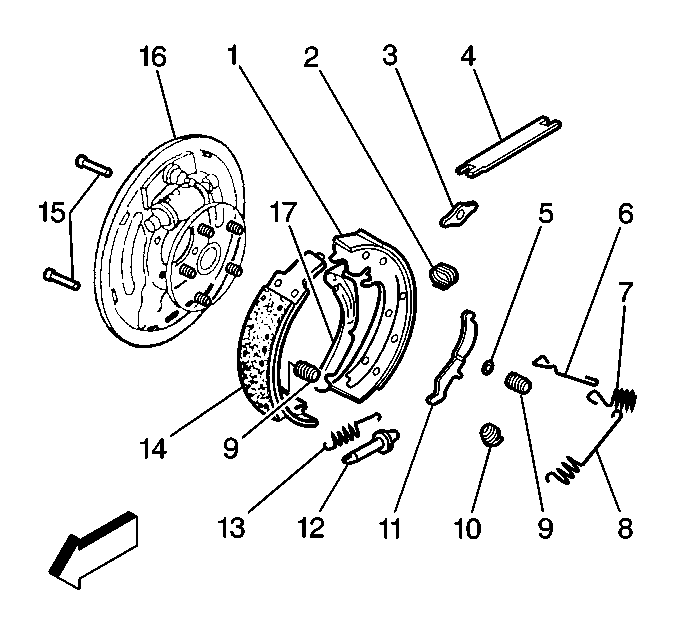GM replacement rear brake shoe material is recommended for all vehicles to maintain the balance between front and rear brake performance. GM replacement brake parts have been carefully selected to provide the proper brake balance for the purposes of stopping distance and control over the full range of operating conditions. Installation of front or rear brake material with performance different from that of GM replacement parts recommended for this vehicle can change the intended brake balance of the vehicle.
Removal Procedure
Caution: Avoid taking the following actions when you service wheel brake parts:
• Do not grind brake linings. • Do not sand brake linings. • Do not clean wheel brake parts with a dry brush or with compressed air.
- Raise the vehicle and support the vehicle with safety stands.
- Remove the tire and the wheel. Refer to Tire and Wheel Removal and Installation in Tires and Wheels.
- Install the pin into the park brake lever. Refer to Parking Brake Cable Adjuster Enabling in Parking Brake.
- Remove the rear brake drum. Refer to Drum Brake Adjustment .
- Remove the rear brake shoe return springs (7,8).
- Remove the hold-down springs (9).
- Remove the hold-down pins (15).
- Remove the shoe guide (3).
- Remove the rear brake shoe actuator (11) and the spring (10).
- Remove the rear brake shoe actuator link (6).
- Remove the rear parking brake lever strut (4) and spring (2).
- Remove the rear brake shoe adjuster spring (13).
- Remove the rear brake shoe adjuster (12).
- Remove the rear brake shoes (1,14).
- Inspect all of the parts for discoloration due to heat or stress. Replace as needed.
- Inspect all of the parts for signs of wear. Replace as needed.
- Inspect the rear brake cylinder for signs of leakage. If any is found, refer to Wheel Cylinder Overhaul .
- Inspect the rear brake drum for scoring and machining tolerance. Refer to Brake Drum Inspection in Drum Brakes.

Installation Procedure
- Lubricate the rear brake backing plate and the adjusting screw threads with a thin coat of white lithium grease.
- Install the rear brake shoes (1,14).
- Install the rear brake shoe adjuster (12).
- Install the rear brake shoe adjuster spring (13). The coils of the adjusting screw spring must not touch the adjusting screw.
- Install the rear park brake lever strut (4) and spring (2).
- Install the rear brake shoe actuator link (6).
- Instal the rear brake shoe actuator (11) and spring (10).
- Install the shoe guide (3).
- Install the hold-down pins (15).
- Install the hold-down springs (9).
- Install the rear brake shoe return springs (7,8).
- Install the rear brake drum to the vehicle. Refer to Brake Drum Replacement .
- Remove the pin to the park brake lever. Refer to Parking Brake Cable Adjuster Enabling in Parking Brake.
- Install the tire and the wheel. Refer to Tire and Wheel Removal and Installation in Tires and Wheels.
- Adjust the rear brakes. Refer to Drum Brake Adjustment .
- Adjust the park brake. Refer to Park Brake Cable Service/Adjustment in Park Brake.
- Remove the safety stands. Lower the vehicle.

Important: Do not interchange the right and left brake shoe adjusting screws.
